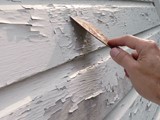How to Deal with Peeling Exterior Paint: Causes, Fixes, and Prevention

Peeling exterior paint isn’t just a cosmetic issue—it’s often a sign that your home’s protective layer is breaking down. In Michigan, where the weather can go from hot and humid to freezing and snowy in just a few months, peeling paint is something many homeowners deal with.
If you’ve noticed bubbling, flaking, or bare spots on your siding or trim, you’re not alone. And the good news? It can be fixed—and even prevented. Here’s everything you need to know about why exterior paint peels, how to handle it, and how to keep it from coming back.
Why Paint Peels in Michigan: Common Causes
Michigan’s climate throws a lot at your home—rain, humidity, snow, ice, and wide temperature swings. These extreme conditions can wear down even the best paint jobs if the surface wasn’t prepped properly or if moisture gets in behind the paint.
Here are the most common reasons exterior paint peels:
1. Moisture Intrusion
When water gets behind the paint—either from rain, snow, ice dams, or high humidity—it can push the paint away from the surface. This is especially common on wood siding or trim where cracks or gaps allow water in.
2. Poor Surface Preparation
If a surface wasn’t properly cleaned, sanded, or primed before painting, the new paint won’t stick well. Dirt, mildew, chalky residue, and old flaking paint can all interfere with adhesion.
3. Low-Quality or Wrong Type of Paint
Using interior paint outdoors or low-grade exterior paint can lead to premature failure. Paint that isn’t made to handle outdoor conditions simply can’t hold up to Michigan’s freeze-thaw cycles and summer UV rays.
4. Temperature and Weather Conditions During Painting
Paint applied in the wrong conditions—like on damp surfaces or during extremely hot or cold weather—won’t cure correctly. This leads to early cracking, blistering, or peeling.
How to Fix Peeling Exterior Paint: Step-by-Step
If you’re ready to tackle peeling paint, the key is to remove the damaged areas completely and repaint the right way. Here’s a breakdown of how to do it:
Step 1: Assess the Damage
Walk around your home and check how widespread the peeling is. If it’s limited to a small area, you might be able to handle the repairs yourself. If large sections are failing—or if you spot signs of moisture damage—it’s best to call a pro.
Step 2: Scrape and Sand
Use a paint scraper or wire brush to remove all loose, flaking paint. Don’t just paint over peeling spots—they’ll continue to fail and pull the new paint off with them. Once scraped, sand the area to create a smooth surface for the new paint to grip.
Step 3: Repair and Clean
Fix any rotted or damaged wood, seal cracks and gaps with caulk, and clean the surface thoroughly. A simple solution of water and mild detergent usually works, but for mold or mildew, you’ll need a cleaner that kills spores.
Step 4: Prime Bare Surfaces
Any exposed wood or previously unpainted areas need primer before you repaint. Primer helps seal the surface and improves adhesion, especially on porous materials like wood or stucco.
Step 5: Repaint with High-Quality Exterior Paint
Once everything is clean, dry, and primed, apply at least two coats of a high-quality exterior paint made for Michigan weather. Look for paint that’s formulated to resist moisture, mildew, and UV damage.
Bonus Tip: Hire a Professional for Best Results
While small repairs can be DIY-friendly, bigger jobs are best left to a professional painting company—especially when peeling paint is widespread or caused by underlying issues like poor ventilation or water damage. At Visual Paint, we handle surface prep, repairs, and expert application for long-lasting results.
How to Prevent Peeling Paint in the Future
Once you’ve gone through the work (or hired the pros) to fix peeling paint, you’ll want to make sure it doesn’t happen again anytime soon. Here’s how to stay ahead of the problem:
1. Prioritize Proper Prep
The most important step in preventing peeling paint is doing the prep right the first time. That means scraping, sanding, cleaning, caulking, and priming before any paint goes on.
2. Choose the Right Paint
Not all paint is created equal. Make sure to use high-quality exterior paint that’s designed for wood, vinyl, or the specific material you're painting—and one that’s formulated for the temperature range and moisture levels we get here in Michigan.
3. Paint in the Right Weather
Avoid painting on days when it’s too cold, too hot, or too humid. Ideally, paint when temperatures are between 50–85°F with low humidity and no rain in the forecast for at least 24–48 hours.
4. Seal Gaps and Keep Moisture Out
Check caulking around windows, doors, and siding joints at least once a year. Reseal any areas where water could sneak in. Proper sealing helps keep the layers beneath the paint dry and protected.
5. Maintain Your Exterior
Don’t wait until peeling is obvious to act. Walk around your home once or twice a year and look for bubbling paint, cracks, or signs of mildew. Small touch-ups and spot repairs now can save you from a full repaint later.
Let’s Fix That Peeling Paint for Good
Peeling exterior paint is a hassle, but it’s also a chance to protect your home and improve its curb appeal. By understanding the causes and using the right repair and prevention steps, you can get your home looking great again—and keep it that way for years to come.
If your home’s exterior is peeling, faded, or just looking a little rough around the edges, we’re here to help.
Contact Visual Paint today for a free quote on your exterior paint job. We specialize in prep, repair, and weather-resistant finishes built for Michigan homes. Let us take care of the details—so you can enjoy the results.
